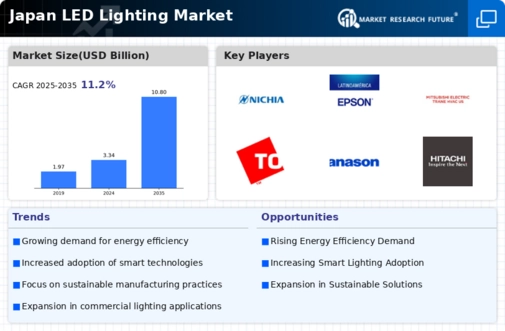Rising Environmental Awareness
There is a growing consciousness among consumers in Japan regarding environmental sustainability, which significantly influences the led lighting market. As individuals and businesses alike seek to reduce their carbon footprints, the demand for energy-efficient lighting solutions has escalated. In 2025, it is projected that approximately 30% of consumers will prioritize eco-friendly products when making purchasing decisions. This shift in consumer behavior is likely to drive manufacturers to focus on sustainable practices, further enhancing the appeal of LED lighting. The increasing emphasis on environmental responsibility is expected to contribute to a substantial growth trajectory for the led lighting market.
Cost-Effectiveness of LED Solutions
The economic advantages associated with LED lighting are a compelling driver for the market in Japan. Although the initial investment in LED technology may be higher than traditional lighting, the long-term savings on energy bills and maintenance costs are substantial. In 2025, it is estimated that businesses and consumers could save up to 50% on energy costs by switching to LED solutions. This cost-effectiveness is particularly appealing in a market where energy prices are on the rise. As more stakeholders recognize the financial benefits of LED lighting, the market is likely to experience accelerated growth, reinforcing its position as a preferred choice in the led lighting market.
Government Regulations and Standards
The regulatory framework in Japan plays a pivotal role in shaping the led lighting market. The government has implemented stringent energy efficiency standards aimed at reducing carbon emissions and promoting sustainable practices. These regulations encourage manufacturers to innovate and produce energy-efficient lighting solutions. As a result, the market has witnessed a surge in demand for LED products that comply with these standards. In 2025, it is estimated that compliance with energy regulations could drive the market growth by approximately 15%. This regulatory environment not only fosters competition among manufacturers but also enhances consumer awareness regarding energy-efficient lighting options, thereby propelling the led lighting market forward.
Technological Advancements in Lighting
Technological innovation is a significant driver of the led lighting market in Japan. The continuous development of LED technology, including improvements in lumens per watt and color rendering index, has led to enhanced product offerings. In 2025, the market is expected to see a rise in smart LED solutions that integrate IoT capabilities, allowing for remote control and automation. This technological evolution not only meets consumer demands for convenience but also aligns with the growing trend of smart homes. The introduction of advanced lighting systems could potentially increase market penetration by 20%, indicating a robust future for the led lighting market.
Urbanization and Infrastructure Development
Japan's ongoing urbanization and infrastructure development initiatives are crucial factors propelling the led lighting market. As cities expand and modernize, there is a heightened need for efficient and sustainable lighting solutions in public spaces, commercial buildings, and residential areas. The government has allocated significant funding for urban development projects, which includes the installation of LED lighting systems. In 2025, it is anticipated that urban infrastructure projects could account for a 25% increase in demand for LED products. This trend underscores the importance of integrating advanced lighting technologies into urban planning, thereby fostering growth in the led lighting market.




















Leave a Comment